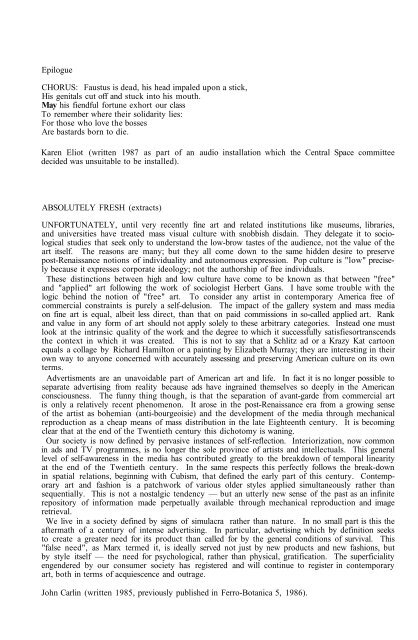Plagiarism: Art As Commodity and Strategies for ... - El plagio literario
Plagiarism: Art As Commodity and Strategies for ... - El plagio literario
Plagiarism: Art As Commodity and Strategies for ... - El plagio literario
You also want an ePaper? Increase the reach of your titles
YUMPU automatically turns print PDFs into web optimized ePapers that Google loves.
Epilogue<br />
CHORUS: Faustus is dead, his head impaled upon a stick,<br />
His genitals cut off <strong>and</strong> stuck into his mouth.<br />
May his fiendful <strong>for</strong>tune exhort our class<br />
To remember where their solidarity lies:<br />
For those who love the bosses<br />
Are bastards born to die.<br />
Karen <strong>El</strong>iot (written 1987 as part of an audio installation which the Central Space committee<br />
decided was unsuitable to be installed).<br />
ABSOLUTELY FRESH (extracts)<br />
UNFORTUNATELY, until very recently fine art <strong>and</strong> related institutions like museums, libraries,<br />
<strong>and</strong> universities have treated mass visual culture with snobbish disdain. They delegate it to sociological<br />
studies that seek only to underst<strong>and</strong> the low-brow tastes of the audience, not the value of the<br />
art itself. The reasons are many; but they all come down to the same hidden desire to preserve<br />
post-Renaissance notions of individuality <strong>and</strong> autonomous expression. Pop culture is "low" precisely<br />
because it expresses corporate ideology; not the authorship of free individuals.<br />
These distinctions between high <strong>and</strong> low culture have come to be known as that between "free"<br />
<strong>and</strong> "applied" art following the work of sociologist Herbert Gans. I have some trouble with the<br />
logic behind the notion of "free" art. To consider any artist in contemporary America free of<br />
commercial constraints is purely a self-delusion. The impact of the gallery system <strong>and</strong> mass media<br />
on fine art is equal, albeit less direct, than that on paid commissions in so-called applied art. Rank<br />
<strong>and</strong> value in any <strong>for</strong>m of art should not apply solely to these arbitrary categories. Instead one must<br />
look at the intrinsic quality of the work <strong>and</strong> the degree to which it successfully satisfiesortranscends<br />
the context in which it was created. This is not to say that a Schlitz ad or a Krazy Kat cartoon<br />
equals a collage by Richard Hamilton or a painting by <strong>El</strong>izabeth Murray; they are interesting in their<br />
own way to anyone concerned with accurately assessing <strong>and</strong> preserving American culture on its own<br />
terms.<br />
Advertisments are an unavoidable part of American art <strong>and</strong> life. In fact it is no longer possible to<br />
separate advertising from reality because ads have ingrained themselves so deeply in the American<br />
consciousness. The funny thing though, is that the separation of avant-garde from commercial art<br />
is only a relatively recent phenomenon. It arose in the post-Renaissance era from a growing sense<br />
of the artist as bohemian (anti-bourgeoisie) <strong>and</strong> the development of the media through mechanical<br />
reproduction as a cheap means of mass distribution in the late Eighteenth century. It is becoming<br />
clear that at the end of the Twentieth century this dichotomy is waning.<br />
Our society is now defined by pervasive instances of self-reflection. Interiorization, now common<br />
in ads <strong>and</strong> TV programmes, is no longer the sole province of artists <strong>and</strong> intellectuals. This general<br />
level of self-awareness in the media has contributed greatly to the breakdown of temporal linearity<br />
at the end of the Twentieth century. In the same respects this perfectly follows the break-down<br />
in spatial relations, beginning with Cubism, that defined the early part of this century. Contemporary<br />
art <strong>and</strong> fashion is a patchwork of various older styles applied simultaneously rather than<br />
sequentially. This is not a nostalgic tendency — but an utterly new sense of the past as an infinite<br />
repository of in<strong>for</strong>mation made perpetually available through mechanical reproduction <strong>and</strong> image<br />
retrieval.<br />
We live in a society defined by signs of simulacra rather than nature. In no small part is this the<br />
aftermath of a century of intense advertising. In particular, advertising which by definition seeks<br />
to create a greater need <strong>for</strong> its product than called <strong>for</strong> by the general conditions of survival. This<br />
"false need", as Marx termed it, is ideally served not just by new products <strong>and</strong> new fashions, but<br />
by style itself — the need <strong>for</strong> psychological, rather than physical, gratification. The superficiality<br />
engendered by our consumer society has registered <strong>and</strong> will continue to register in contemporary<br />
art, both in terms of acquiescence <strong>and</strong> outrage.<br />
John Carlin (written 1985, previously published in Ferro-Botanica 5, 1986).






